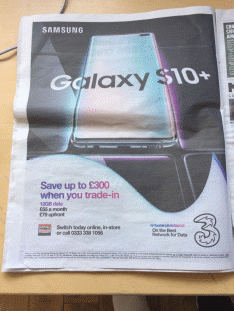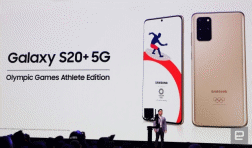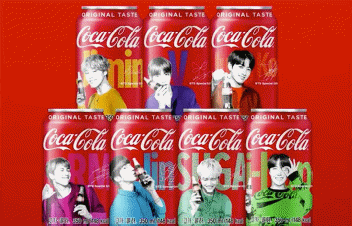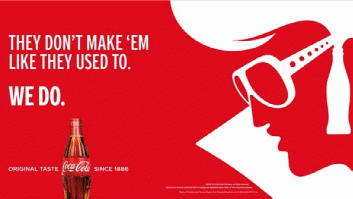Integrated Marketing Communication Strategies (IMC)
IMC Campaign: Samsung Galaxy Line
As the chosen IMC campaign conducted by Samsung, the advertising of the Galaxy smartphone line is analyzed. The world-famous digital corporation has a multi-million target audience, and the Galaxy brand is one of the recognized global leaders in terms of sales. In this regard, the promotion of smartphones of this line is carried out on different media platforms. For instance, Samsung (2020) offers TV viewers a vivid commercial in which the girl demonstrates the technical features of the new flagship Galaxy S20 through shooting and photographing a vivid youth party. Typical techniques used in the television space are applied: accompanying music, quick frame change, as well as a young and active audience.
Another example of a platform for advertising new Galaxy smartphones is online magazines. O’Brien (2019) analyzes how successful Samsung’s techniques are in attracting the attention of the target audience and offers an image in which a young man explores the possibilities of a new smartphone in an enlarged format. In Figure 1, this frame is presented, and O’Brien (2019) describes the new product through its basic features and new options, which is consistent with the principle of magazine advertising.

Despite the fact that today, advertising in periodicals influences a smaller number of consumers than in the digital space, relevant promotional materials appear in popular newspapers. In particular, Arkin (2019) provides an example of advertising for the Galaxy S10+ smartphone, which is demonstrated in the Metro edition. In Figure 2, the author of the blog gives the photographs of this advertisement, and readers can pay attention to the typical techniques used by print media – maximum images and the key characteristics of proposed goods (Arkin, 2019). Limited space on pages requires displaying the most important information, and significant data are included in the description – prices, sale details, and the product image.

The publication of advertising materials on social media is one of the most promising and effective initiatives for marketing communication campaigns. In its official group, Samsung (2018) published a post on the Galaxy smartphone lineup and proposed four types of models. The characteristic feature of this advertisement was the offer of bonus goods that consumers could receive for free in case of purchase. This method of attracting attention is one of the most effective tools to increase customer activity.
Sales Promotion Program
As an example of a marketing communication strategy used by Samsung to promote sales, the program to release a unique line of Galaxy S20 + smartphones specifically for the 2020 Olympic Games 2020 in Tokyo can be considered. According to Bonifacic (2020), this campaign does not apply to advertising since ordinary consumers will not be able to buy this model, and only athletes will be able to use these gadgets. In Figure 3, the presentation of this device is demonstrated (Bonifacic, 2020). However, despite the limitations of this line and the lack of sales to a wide range of users, the program is significant as a valuable project that stimulates interest in the brand and promotes Samsung’s products in the digital market. When comparing this campaign with the available Galaxy brand smartphones, one can note that the main difference is access to purchases. Nevertheless, the previous advertising offers have one aspect in common with the sales promotion project through the presentation of the limited edition Galaxy S20 + – Samsung attracts the interest of the target audience through active work on updating its products and introducing innovations.

As a strength of the proposed sales promotion program, one can note Samsung’s attentive approach to sports life and socially-oriented business practices. In the conditions of continuous innovations and constantly appearing novelties of digital technologies, the practice of creating a unique line of smartphones helps enhance the credibility of the corporation and its recognition in the target market. Nevertheless, this sales promotion program has one obvious weakness – the inability to offer any of the new smartphones to ordinary consumers. Some users of modern gadgets may be unhappy with such targeted marketing and the intention of Samsung representatives to satisfy the interests of only athletes. Therefore, this campaign may be perceived ambiguously by fans of the corporation, and, in particular, the Galaxy line.
Global Brands, Cultures, and Advertisement
Individual brands distribute their products globally and are major players in the world trading market. At the same time, the promotion of goods in different regions requires unique approaches to not only attract the target audience but also address the cultural characteristics of consumers from different countries. As an example, the Coca-Cola ad campaign can be reviewed, in particular, its sales concepts in the UK and South Korea. In Figure 4, an updated line of refreshing drinks is presented in which the participants of the famous South Korean K-pop band are represented in one of the online magazines (Khamidkhon, 2018). In Figure 5, the Coca-Cola ad campaign published in another online magazine demonstrates the image of Elvis Presley as one of the symbols of the rock-n-roll era and suggests recalling more than a century of the brand history (Relevance News Desk, 2019). Both approaches to promoting the same product differ in presentation styles and advertising objectives.


The South Korean advertising reflects the current interests of this country and offers consumers products that can attract their interest and cause increased demand. In this Asian country, K-pop culture is a mass phenomenon, and the publication of the images of a famous band directly characterizes what entertains the modern target audience most of all. Unlike the European advertising, the South Korean campaign focuses on the principle of interaction with the youth and seeks to create excitement by drawing a parallel between the famous brand of refreshing drinks and popular culture. The British advertising campaign, conversely, aims to communicate with audiences of different ages, including the older generation, and focuses on engaging a well-known historical figure as the main marketing practice. Conservatism and traditional views on promotion policies in the UK are the key reasons for this approach and differ from popular and modern South Korean trends.
From the standpoint of standardizing the brand, Coca-Cola applies similar principles for promoting its products in the world, in particular, influencing target consumers through the demonstration of characteristic cultural phenomena. In all advertising campaigns, including those mentioned by Khamidkhon (2018) and Relevance News Desk (2019), the dominance of red and white colors contributes to brand recognition and consumer acceptance. However, when discussing these advertising projects from the standpoint of localization, more unique and narrow practices are characteristic for strengthening the brand value. The brightness and wide range of Coca-Cola products in the Asian regions do not coincide with the classic and concise advertising programs in Europe. As a result, the corporation follows distinctive strategies for promoting its products intentionally, thereby creating offers for individual countries and achieving success through the maximum personalization of the brand. The examples of the South Korean and British ads of the new line of refreshing drinks prove how differently the same products can be promoted among the population of these countries and what approaches are efficient to maintain demand.
For both promotional offers, unique appeals are applied, although, for each of them, a culturally oriented context is characteristic. In South Korea, Coca-Cola focuses on modern music trends and engages consumers through the contemporary trend. In the UK, conversely, traditional cultural motifs are involved, which makes it possible to arouse interest in the brand among buyers of different ages. Regarding the relevance of both approaches, the South Korean campaign seems more reasonable. The trend for contemporary culture is in demand in this region, and the publication of images of famous singers is an effective marketing move. For the British campaign, the image of Elvis Presley may not be the most successful since this character of rock-n-roll culture is more characteristic of American history. If the Coca-Cola office in the UK used its national musical figure, this could have a greater effect on the public, thereby increasing sales.
References
Arkin, R. (2019). The Samsung Galaxy S10+ and the Metro. Rafi Arkin Blog. Web.
Bonifacic, I. (2020). Samsung created an Olympics edition Galaxy S20+ for athletes. Endadget. Web.
Khamidkhon. (2018). Coca-Cola to feature K-pop boy band BTS on cans and bottles in South Korea. Branding in Asia. Web.
O’Brien, K. (2019). Samsung Galaxy campaign looks to ‘The Future’ with a soundtrack from the past. The Drum. Web.
Relevance News Desk. (2019). Coca Cola U.K. launches ‘We Do’ ad campaign ahead of sugar tax. Relevance. Web.
Samsung. (2020). Galaxy S20: Official TVC – Found with Galaxy S20 series|Samsung [Video]. YouTube.
Samsung. (2018). Don’t miss out on our Back to School Promo! Buy a Samsung Galaxy under GHS500 and get cool gifts [Image attached]. Facebook.
